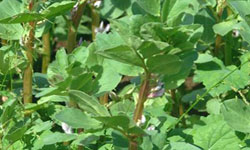
The difficult weather and soil conditions earlier this Spring have not made it easy for growers to apply pre-emergence herbicides in peas and beans, but there are effective post-em options to be considered, says BASF.
"Due to their uncompetitive nature, peas and beans suffer heavily from weed competition during their early stages of growth. Early weed removal is essential to protect yield and quality. This year growers have managed to drill their peas and beans, but have been held up applying pre-emergence herbicides, because it has been too wet or too windy. Difficult pre-em conditions could now drive many growers to look at their post-em options," says John Young, BASF Pulse Product Manager.
John explains that Basagran SG (bentazone) is a one of the rare post-emergence options in beans and peas and that UK growers have this year only to use Pulsar (bentazone +MCPB) in mix with cyanazine, to good effect in peas.
"The loss of cyanazine at the end of this year will have an unfortunate knock-on effect on the popular post-em pea herbicide Pulsar as its use depends on the addition of cyanazine. But growers are still able to use this combination on most varieties of combining and vining peas as well as forage and pigeon feed peas this year. Bearing in mind the difficulties already encountered, this is a useful fall back position," says John.
As a reminder, Pulsar and cyanazine are contact-acting herbicides for post-emergence broad-leaved weed control in peas.
"This mixture controls many key weeds including Black-bindweed, Charlock, Chickweed, Red dead-nettle, Fat-hen, Fumitory, Groundsel, Mayweeds, Small nettle, Orache, Redshank and Shepherd's-purse. The mix can be used from when the crop has three fully expanded leaves until before the flower buds can be found in the terminal shoot. Best results can be expected when weeds are at the seedling stage," advises John.
"Post-emergence options for broad-leaved weed control in winter field beans, spring beans and broad beans remain solely with Basagran SG. It is also recommended in vining and combining peas as one of the proper post-emergence products, applied in peas from the third node onwards. It offers more flexibility particularly when there is a need for late or follow-up control of difficult weeds such as Cleavers or Black nightshade. It also gives good control of Volunteer rape, Charlock, Fools parsley, Redshank and Shepherd's-purse," says John.
Before spraying, it is important to test the leaf wax using a Crystal Violet test which makes sure that the crop has adequate wax levels present to protect it. Wax levels vary depending on the variety and the weather, with wind, rain and frost all having an adverse effect. Also such herbicide applications should be avoided in hot, sunny conditions or when the temperature is at, or are likely to exceed 21?C.
There are also opportunities to control grass-weeds such as Annual Meadow-grass, Wild-oats, Volunteer cereals or Black-grass in peas and beans. According to John, either Aramo (tepraloxydim) or Laser (cycloxydim) will do the trick. "Aramo in particular continues to be a useful tool in programmes to manage difficult black-grass across the rotation."
